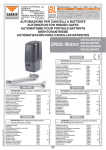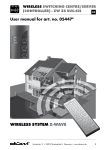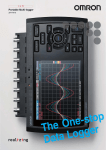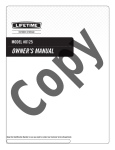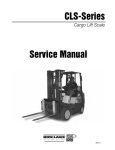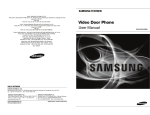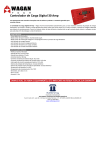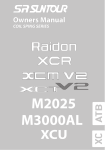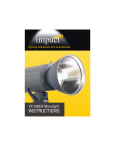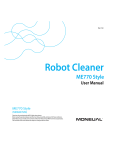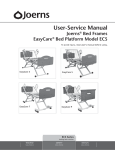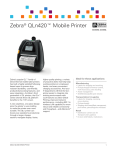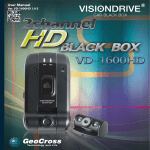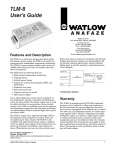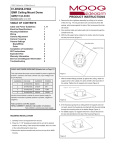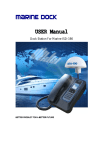Download User`s Manual t Manual de Usuario t Guide d`Utilisation
Transcript
Item No. / Artículo No / Article n° 2547
User’s Manual t Manual de Usuario t Guide d’Utilisation
China Design Patent / Diseño patentado en China / China conception de brevet ZL 2010 3 0642300.2
China Utility Patent / Utilidad patentado en China / China utilitaire de brevet 2012204085950
User’s Manual—Read before using this equipment
ENGLISH
Item No. 2547
.0#*-*5:t3"1*%4&561t*/45"/5108&3
© 2013 Wagan Corporation. All Rights Reserved
Wagan Tech and wagan.com are trademarks used by Wagan Corporation
2
Solar e Power™ Cube 1500 Plus by Wagan Tech®
$0/5&/54
Introduction .........................................................................................................................5
ENGLISH
8BSOJOHT$BVUJPOT"OE/PUFT .............................................................................................5
Warnings—General .............................................................................................. 5
.BKPS'FBUVSFT ....................................................................................................................6
$POUSPM1BOFM.......................................................................................................................7
Digital LED Voltmeter (Battery Status) ....................................................................... 8
100Ah Gel/AGM Hybrid Battery ............................................................................ 8
Battery Disconnect Switch ...................................................................................... 9
External Battery Terminals ...................................................................................... 9
$IBSHJOH5IF4PMBSF1PXFS$VCF ...................................................................................... 10
$IBSHJOH.FUIPET ............................................................................................................. 11
AC Charging Adapter ..........................................................................................11
DC Charging Adapter ..........................................................................................12
Charging With Solar Panels ..................................................................................13
Solar Panel Positioning .........................................................................................14
0VUQVU1PXFS .................................................................................................................... 15
Using the AC Outlet Power Receptacles ..................................................................15
12V DC Accessory Outlets ....................................................................................16
External Battery Terminals .....................................................................................17
"$0QFSBUJOH5JNF6TJOH*OWFSUFS ...................................................................................... 17
%$0QFSBUJOH5JNF ............................................................................................................ 18
+VNQ4UBSU8BSOJOHT ......................................................................................................... 18
+VNQ4UBSU1SPDFEVSF8JUI6TFS4VQQMJFE+VNQFS$BCMFT .................................................... 19
Connection To a Positive Grounded Vehicle ............................................................ 20
7FIJDMF#BUUFSZ#PPTUJOH6TJOHUIF%$$IBSHJOH"EBQUFS ....................................................20
1PXFS&YQBOTJPO0QUJPOT ..................................................................................................20
3
www.wagan.com
User’s Manual—Read before using this equipment
External Battery Connection Procedure ...................................................................21
Bypassing The Internal Battery ...............................................................................21
"EEJOH4PMBS1BOFMT ..........................................................................................................22
Using The Internal Solar Charge Controller ............................................................ 22
User-Supplied External Controller and Solar Panels ................................................. 22
.BJOUFOBODF .....................................................................................................................22
Cleaning ............................................................................................................ 22
Fuse Replacement—DC Charging Adapter ............................................................. 23
5SPVCMFTIPPUJOH(VJEF .......................................................................................................23
3FDZDMJOH%JTQPTBM ............................................................................................................24
4QFDJmDBUJPOT ....................................................................................................................24
Solar e Power Cube Shipping Specifications .......................................................... 24
12 Volt DC Battery and Outlets ............................................................................. 24
Inverter .............................................................................................................. 25
AC Charging Adapter ......................................................................................... 25
DC Charging Adapter ......................................................................................... 25
Solar Panels and Solar Charge Controller .............................................................. 25
8"("/$PSQ-JNJUFE8BSSBOUZ ........................................................................................26
© 2013 Wagan Corporation. All Rights Reserved
Wagan Tech and wagan.com are trademarks used by Wagan Corporation
4
ENGLISH
Adding Batteries to the System ............................................................................. 20
Solar e Power™ Cube 1500 Plus by Wagan Tech®
*/530%6$5*0/
ENGLISH
Congratulations on your purchase of Wagan Tech®’s Solar e Power™ Cube 1500 Plus. As
supplied, the Solar e Power Cube is a balanced electrical system that can power AC appliances
and operate and charge a variety of communication and entertainment devices. In an emergency, it can boost a dead car battery. On the job site, it can power tools where no power lines or
generators exist. At night, it can power a variety of light sources from DC spotlights to AC floodlights. At the campground it can power an RV Microwave oven, water pumps and entertainment
equipment. The Solar e Power Cube is expandable: As your needs change, external batteries
and solar panels can be added to the system to increase run time. This flexibility preserves your
investment in Solar e Power Cube.
The internal battery, the heart of the system, is of high quality and with proper care and frequent
charging will last for years. Wagan Tech, with proven technology DC to AC inverters, has
crafted the internal power inverter for use with the Solar e Power Cube.
A supplied automatic AC to DC Charging Adapter efficiently charges and maintains the Solar e
Power Cube’s internal batteries.
Read and understand all warnings, cautions and notes included in this manual before using the
Solar e Power Cube. Follow instructions provided by your vehicle and other device manufacturers intended to be used with the Solar e Power Cube.
Keep these instructions for future reference.
Fully Charge The Solar e Power Cube Before First Use.
8"3/*/(4$"65*0/4"/%/05&4
WARNINGS identify important safety concerns when operating this equipment. Failure to follow
these warnings could result in personal injury or loss of life.
CAUTIONS identify conditions that can cause damage to equipment
NOTES identify operating details.
8BSOJOHT(FOFSBM
Shock or fire hazard—The Solar e Power Cube generates the same potentially lethal AC power
as a normal household wall outlet. Treat it with the same respect that you would any AC outlet.
Explosion Hazard—Do not use this product around flammable fumes or gasses, such as in the
bilge of a gasoline powered boat, or near a propane tank. Do not use Solar e Power Cube in
an enclosure containing automotive-type lead-acid batteries. These batteries, unlike the sealed
battery pack in the Solar e Power Cube, vent explosive hydrogen gas, which can be ignited by
sparks from electrical connections or disconnections.
When working on electrical equipment, always make sure that someone is nearby to help you in
an emergency
5
www.wagan.com
User’s Manual—Read before using this equipment
Heavy Lifting—This unit weighs about 84 pounds (38 kg). Proper care should be taken when lifting the unit. Two people should lift this product using the two shape-molded handles located on
the side of the Solar e Power Cube.
ENGLISH
Limitations on Use—The Solar e Power Cube has not been tested for use with life support systems
or other medical equipment or devices. The user assumes all risk if medical devices are used
with this product.
Temperature Limits—Do not expose Solar e Power Cube to temperatures in excess of 104 °F
(40 °C) or below 32 °F (0 °C)
Unit is Not Waterproof—Do not expose this unit to rain or heavy moisture.
."+03'&"563&4
t 1500 watt Power Inverter (3600 watts peak)
t Two AC Outlets
t Two 12 volt Automotive Outlets for powering DC appliances (loads to 15 amps)
t Two USB Power Ports for charging/operating cell phones, PDAs, and MP3 players
t AC Charging Adapter with 5 amp output
t DC Charging Adapter (fused)
t Digital LED Voltmeter for checking battery status
t Battery Status Push-Button
t Battery Disconnect Switch
t Solar Panel Terminals to connect solar panels to the internal Solar Charge Controller
t Terminals to connect additional batteries
t Storage Hatch for chargers and cables
t Shape molded handles for easy lifting/wheels for positioning the Solar e Power Cube.
t 100Ah Gel/AGM hybrid battery for long life
t 80 Watts (5 × 16 watts) of solar panels for charging the internal battery.
© 2013 Wagan Corporation. All Rights Reserved
Wagan Tech and wagan.com are trademarks used by Wagan Corporation
6
Solar e Power™ Cube 1500 Plus by Wagan Tech®
$0/530-1"/&ENGLISH
The Control Panel contains a Digital LED Voltmeter for reading battery status, a Battery Status
Push-Button to turn on the meter, Inverter ON/OFF switch, two AC Outlets, two USB and two
12 volt Accessory Outlets. Two LEDs indicate the operating condition of the Inverter. The green
Power LED, when lit, indicates normal operation and that AC is present at the outlets. The red
Fault LED indicates the Inverter is shut down because of any of the following reasons: over voltage, under voltage, over temperature or overload. Refer to the Troubleshooting section to resolve
the problem. Two terminals allow additional solar panels to be connected to the internal Solar
Charge Controller. The Battery Disconnect Switch is located to the left of the control panel. A
Storage Hatch contains the DC and AC Charging Adapters.
Inverter
Power Switch
Digital LED
Voltmeter
INVERTER
VOLTMETER
FAULT
POWER
Voltmeter
Push-button
Green Inverter
Power LED
USB Outlets
DISPLAY
1500W, 115V AC
Red Inverter
Fault LED
2.1A USB
1.0A USB
2 AC Outlets
(Inverter)
Solar Panel
Terminals
Positive (+)
SOLAR
TERMINALS
Negative (−)
12V DC Accessory Outlets
Control Panel
7
www.wagan.com
ENGLISH
User’s Manual—Read before using this equipment
Storage Hatch
%JHJUBM-&%7PMUNFUFS#BUUFSZ4UBUVT
The Digital LED Voltmeter provides the user with the current charge state of the internal battery. It
is the user’s responsibility to periodically monitor the battery charge and to recharge the battery
after each use. Recharge every three months even if the Solar e Power Cube is not used.
NOTE: Battery status (voltage) is accurate with Charging Adapters disconnected
1. Press and hold the Battery Status Push-Button for 3 seconds.
2. The Digital LED Voltmeter (Battery Status meter) will display the battery voltage.
= 13.5V DC
Battery is fully charged
≥ 12.6V DC
Battery is ready for use
≤ 12.0V DC
Battery needs some charging
< 10.5V DC
Battery is discharged, charge immediately
"I(FM"(.)ZCSJE#BUUFSZ
The Solar e Power Cube is equipped with the latest in battery technology. Supplied batteries
combine the charging characteristics and compatibility of AGM valve regulated, sealed leadacid batteries with the improved performance of gel batteries in low discharge rate and high
ambient temperature applications.
These batteries are electrically compatible with AGM batteries for expansion and also follow
AGM charge characteristics. The gel component in them improves performance in low discharge
applications. It is recommended that only AGM batteries be used for long term expansion or
replacement because they are more compatible with portable applications and do not spill or
leak.
© 2013 Wagan Corporation. All Rights Reserved
Wagan Tech and wagan.com are trademarks used by Wagan Corporation
8
Solar e Power™ Cube 1500 Plus by Wagan Tech®
CAUTION—BATTERY LIFE:
Repetitive quick deep discharging of any rechargeable battery will reduce the capacity and life
of the battery. Frequent charging will preserve battery life.
ENGLISH
#BUUFSZ%JTDPOOFDU4XJUDI
A Battery Disconnect Switch allows the user to turn off the battery whenever the Solar e Power
Cube is not in use and to be stored for a prolonged period of time. This helps preserve the battery’s charge. Also, it is recommended to turn this switch off whenever transporting or moving the
Solar e Power Cube to prevent any electrical hazard caused by excessive vibration. The Battery
Disconnect Switch is located to the left of the control panel. For early models, the fan will operate when the Battery Disconnect Switch is closed (ON). For later models, fans operate when the
Inverter is turned on.
ON
NE
CT S
W ITC H
OFF
BATTERY DI S C O
N
CAUTION—LIVE BATTERY TERMINALS:
When the Battery Disconnect Switch is closed (ON), the Battery Terminals are connected to the
internal battery. Proper care must be taken to keep Battery Terminals covered (insulated) at all
times when not in use.
&YUFSOBM#BUUFSZ5FSNJOBMT
Red and black terminals labeled “Battery Terminal” are located above each wheel. Battery
Terminals can be used for DC load applications greater than 15 amps, such as jump starting
a small motor vehicle with user-supplied jumper cables. Care must be taken to ensure that the
battery is not over-discharged. When using the Battery Terminals for high current output for a
prolonged period of time, it is recommended that the Inverter switch be turned ON to operate
the cooling fan. The Battery Disconnect Switch must be on to use the Battery Terminals. Battery
Terminals can be used to connect additional (external) batteries to increase capacity of the battery bank. The illustration that follows shows the Negative battery terminal.
9
www.wagan.com
ENGLISH
User’s Manual—Read before using this equipment
Negative (−) Battery Terminal
$)"3(*/(5)&40-"3&108&3$6#&
Make Sure The Solar e Power Cube Is Fully Charged Before First Use.
It is important to charge the Solar e Power Cube for 24 hours before initial use. Recharge after
each use. When storing for long periods of time, it is recommended to charge the battery once
every 3 months. Failure to follow these instructions can damage the battery and reduce the battery’s ability to hold a charge
CAUTION—RISK OF DAMAGE TO BATTERY:
t All lead-acid batteries must be charged at least every 3 months, especially in warm
environments. Leaving a battery in a discharged state, or not charging every 3 months
risks permanent damage.
t Do not attempt to charge Solar e Power Cube battery if it is frozen. A frozen battery
should be gradually warmed to 32 °F (0 °C) before charging.
t Caution: Don’t undercharge the Solar e Power Cube battery.
t Repeated incomplete charging reduces battery life.
t During charging, if the battery status button is pressed, the voltage displayed will be
that of the charger.
t To read battery voltage the user MUST first disconnect the charger from the unit.
t Press the battery status push button. If the reading shows less than 13.5 volts, then
continue charging.
t If the battery reading is above 13.5 volts, allow the battery to rest for one hour.
t During rest period the battery will “settle” to its real voltage. After the rest period, take
the battery status. This reading will display an accurate battery voltage.
© 2013 Wagan Corporation. All Rights Reserved
Wagan Tech and wagan.com are trademarks used by Wagan Corporation
10
Solar e Power™ Cube 1500 Plus by Wagan Tech®
t Make sure the Solar e Power Cube is fully charged before first use.
ENGLISH
$)"3(*/(.&5)0%4
Factory supplied equipment allows the Solar e Power Cube to be charged using:
AC Charging Adapter
DC Charging Adapter
Solar Panels
(Charging from your
vehicle as you drive)
"$$IBSHJOH"EBQUFS
The Solar e Power Cube is supplied with a fully automatic AC Charging Adapter. The indicator
light on the top of the adapter shows red when the battery is charging and green when the battery has reached a full charge. The charger will continue to trickle charge the battery to maintain
a full charge when the green light is on. The Charging Adapter has a wide range of input voltages and automatically adjusts to 115V or 220V depending on the AC source. Note that initial
AC charge can take up to 48 hours. The AC Charging Adapter connects to the Solar e Power
Cube through either DC Accessory Outlet located on the control panel.
AC Wall Socket
DC Plug
LED Indicator
Plug AC Charging Adapter into wall socket
To charge the Solar e Power Cube using the AC Charging Adapter:
11
www.wagan.com
User’s Manual—Read before using this equipment
MAKE SURE ALL SOLAR E POWER CUBE SWITCHES ARE SET TO OFF.
1. Connect the AC Charging Adapter to an AC wall socket.
ENGLISH
2. Insert the charger’s DC plug into the Solar e Power Cube’s DC Outlet.
3. Turn ON the Battery Disconnect Switch.
4. Charging is complete when the light on the AC charger turns green.
5. After charging the battery, disconnect the adapter from the AC wall socket first, then
from the DC Outlet.
6. Turn OFF the Battery Disconnect Switch if the Solar e Power Cube is not in use.
7. Store the AC Charging Adapter in the Storage Hatch.
%$$IBSHJOH"EBQUFS
The DC Charging Adapter is a cord with a fused DC accessory plug at both ends. Both plugs
are fused at 15 amps to prevent damage if there is an inadvertent short. Refer to the maintenance section to replace a fuse if necessary.
Plug DC Charging Adapter into vehicle DC accessory socket
To charge the Solar e Power Cube using the DC Charging Adapter:
ONLY USE THE DC CHARGING ADAPTER SUPPLIED WITH THIS UNIT. DO NOT CONTINUOUSLY CHARGE FOR MORE THAN
16 HOURS USING THE DC TO DC METHOD.
1. Note that the engine must be running while charging the Solar e Power Cube to avoid
discharging the vehicle’s battery.
2. Make sure all Solar e Power Cube switches are set to OFF.
3. Plug the DC Charging Adapter into the Solar e Power Cube’s DC Outlet.
4. Plug the other end of the DC Charging Adapter into the vehicle’s accessory socket
(cigarette lighter socket).
© 2013 Wagan Corporation. All Rights Reserved
Wagan Tech and wagan.com are trademarks used by Wagan Corporation
12
Solar e Power™ Cube 1500 Plus by Wagan Tech®
5. Turn ON the Battery Disconnect Switch
6. Periodically remove one DC plug and check the Digital LED Voltmeter to determine
when charging is complete (usually 13.5V is considered fully charged)
ENGLISH
7. After charging the battery, disconnect the DC Charging Adapter from the vehicle accessory socket first, then from the Solar e Power Cube DC Outlet.
8. Turn OFF the Battery Disconnect Switch if Solar e Power Cube is not in use.
9. Store the DC Charging Adapter in the Storage Hatch.
Do not leave the Solar e Power Cube connected to your vehicle’s DC socket when the engine is
turned off.
CAUTION—EQUIPMENT DAMAGE:
t While the Solar e Power Cube is being charged with the DC Charging Adapter from
your vehicle, do not operate the Inverter with a load of over 100 watts. Further, do not
plug in or operate any DC appliance from the Solar e Power Cube that requires more
than 10 amps. Either action may blow a vehicle fuse.
t Always remove the DC Charging Adapter from the vehicle’s DC socket before starting
the vehicle.
t Disconnect the Solar e Power Cube from the vehicle’s DC socket when the engine is
turned off to prevent discharging the vehicle’s battery.
t Always remove the DC Charging Adapter from the vehicle’s DC socket before starting
the vehicle.
$IBSHJOH8JUI4PMBS1BOFMT
The Solar e Power Cube is supplied with five 16W solar panels (80 watts ). The top two panels
are hinged at the sides of the Solar e Power Cube and the lower two panels slide out from the
center of the Solar e Power Cube. The panels must be fully opened/extended to allow maximum
exposure to sunlight.
13
www.wagan.com
ENGLISH
User’s Manual—Read before using this equipment
Extending Solar Panels
CAUTION —Keep any objects from resting on the solar panels. This will reduce panel exposure
to sunlight and slow battery charging. Heavy objects can damage the solar panels.
Factory supplied solar panels have a combined rating of 80W, however, actual charging power
may vary depending on environmental factors and sun intensity in your region. The approximate
charging time for the Solar e Power Cube using the supplied solar panels is 18 hours of peak
sunlight. Additional solar panels may be connected to reduce charging time. The internal Solar
Charge Controller is rated at a maximum of 20A. Do not connect more than 300W of solar
panels, including the 80W panels that are attached. Doing so will damage the Solar Charge
Controller and void the warranty. Additional solar panels must have the same voltage ratings as
factory supplied panels. (See panel specifications at the rear of this document).
CAUTION—SOLAR CHARGE CONTROLLER AMPERAGE LIMIT:
The Solar Charge Controller is rated at a maximum of 20A. Do not connect more than 300W
of solar panels, including the 80W panels that are supplied. Doing so will damage the Solar
Charge Controller and void the warranty.
4PMBS1BOFM1PTJUJPOJOH
To ensure maximum power from the solar panels, position the panels perpendicular to the position of the sun. For best results, the solar panels should be in line with the expected path of the
sun. Panel placement varies depending on your location. It is recommended that panel positions
are checked and adjusted every 3 hours to ensure solar absorption is optimized.
CAUTION—EQUIPMENT DAMAGE:
When adding solar panels, make sure the solar panels are rated for 12V systems. If you are
connecting multiple solar panels to the Solar Panel Terminals, make sure the combined voltage is
no greater than 17V DC.
© 2013 Wagan Corporation. All Rights Reserved
Wagan Tech and wagan.com are trademarks used by Wagan Corporation
14
Solar e Power™ Cube 1500 Plus by Wagan Tech®
Do not connect more than 300W (total) of solar panels, including the 80W panels that are
attached. Doing so will overload the Solar Charge Controller and prevent the controller from
charging.
ENGLISH
Make sure all air vents are not blocked while the Solar e Power Cube is in use. It is essential for
maintaining optimum performance.
065165108&3
6TJOHUIF"$0VUMFU1PXFS3FDFQUBDMFT
The Solar e Power Cube’s Inverter can operate most AC appliances or a combination of appliances up to 1500 watts. The Inverter is capable or handling up to 1500 watts for an extended
period of time when additional batteries are connected. However, additional batteries will not
increase the Inverters wattage capability beyond 1500W. Operating time (run time) is dependant on the AC load (watts) and the charge and condition of the Solar e Power Cube’s internal
battery and any connected external batteries. Low wattage AC loads and a full battery charge
result in longer operating times. Be sure to turn off or disconnect any AC appliance not in use.
Converting DC battery power to AC generates heat. To minimize heat buildup and possible thermal shutdown, remove obstacles blocking or hindering airflow between the intake and exhaust
sides of the Solar e Power Cube. Ambient temperatures above 25 ºC will reduce the Inverter’s
ability to cool effectively, thus affecting operating times.
This Inverter produces Modified Sine Wave (MSW) AC. The waveform differences can be seen
below. Both waveforms have the same electrical energy, however some average reading AC
voltmeters can not properly read MSW. Readings on a non-TRUE RMS meter will display up to
30 volts lower voltage than sine wave AC.
Pure Sine Wave
Modified Sine Wave
CAUTION—MODIFIED SINE WAVE:
t Some rechargeable devices are equipped with a separate AC charger. These devices
are likely to operate properly with this Inverter. Rechargeable devices that have builtin chargers (see device owner’s manual) may not operate properly with this type of
Inverter.
t Some motorized devices may operate at excessively elevated temperature when used
with this Inverter. During first use with this Inverter, check for excessive motor temperature. Abnormally elevated temperature of the motor is an indication that they should not
be used with this Inverter.
15
www.wagan.com
User’s Manual—Read before using this equipment
t Do not use the following with modified sine wave inverters:
t Small battery-operated appliances like flashlights, razors and night lights that
can be plugged directly into an AC receptacle to recharge.
ENGLISH
t Some chargers for battery packs used in power hand tools. These affected
chargers display a warning label stating that dangerous voltages are present
at the battery terminals.
To use the AC Power Inverter:
1. Turn ON the Battery Disconnect Switch
2. Connect the AC appliance or appliances to either AC Outlet.
3. 5VSOUIF1PXFS*OWFSUFS0/CZQPTJUJPOJOHUIFTXJUDIUPUIFitw0/QPTJUJPO
4. When the Inverter Power Indicator LED is green, the Inverter is operating.
5. Turn on one AC appliance and observe the Power Indicator and FAULT LEDs.
t If the LED remains green, proceed to turn on the second appliance.
t If the Power Indicator LED continues to remain green, then both appliances are
operating properly.
t If the red FAULT LED light is lit, then remove all loads and restart the inverter
t If the Power indicator LED is not lit, then reduce the AC load. If the Inverter is
still not operating, refer to the Troubleshooting table at the end of this User’s
Manual.
6. After appliance use, turn OFF the Inverter switch
7. Remove AC appliance plug(s) from the AC Outlets on the Solar e Power Cube
8. Recharge the Solar e Power Cube as soon as convenient.
Note: The external cooling fan operates whenever the Inverter is on. The cooling fan helps
maintain Solar e Power Cube internal temperature when products with high power requirements
are in use.
7%$"DDFTTPSZ0VUMFUT
DC Accessory Outlets can power a DC load up to 15 amps each. Overloading a port will result
in tripping a self-resetting circuit breaker. Removing the overload automatically restores power to
the DC Accessory Outlet once the circuit breaker has cooled.
CAUTION—Do not insert an automotive cigarette lighter into the Outlet. There is no pop-out
feature and excessive heat may damage the Outlet.
To use an Accessory Outlet:
1. Open the dust cover over the DC Accessory Outlet.
2. Insert the 12V DC accessory plug into the DC Outlet.
3. Turn ON the Battery Disconnect Switch
4. Operate the appliance as usual.
© 2013 Wagan Corporation. All Rights Reserved
Wagan Tech and wagan.com are trademarks used by Wagan Corporation
16
Solar e Power™ Cube 1500 Plus by Wagan Tech®
5. After use, disconnect the accessory plug from the DC Accessory Outlet and store the
accessory.
6. Replace the DC Outlet’s dust cover.
ENGLISH
7. Turn OFF the Battery Disconnect Switch
8. Recharge the Solar e Power Cube as soon as convenient.
&YUFSOBM#BUUFSZ5FSNJOBMT
The Solar e Power Cube Battery Terminals can be used to power DC loads greater than 15
amps. Proper care should be taken, however to prevent the load from over-discharging the
Solar e Power Cube’s battery. Jump starting a vehicle involves very high current that can cause
damage to person and property. Extra care MUST be taken to prevent any accidents. Always
make sure the Inverter switch on the front panel is turned OFF and all DC and USB devices are
disconnected before attempting to connect to or jump start using the Battery Terminals. Engine
cranking should be done in three-second bursts. If the engine does not start after seven attempts,
discontinue and look for other problems.
"$01&3"5*/(5*.&64*/(*/7&35&3
Below are typical AC products that can be operated by the Solar e Power Cube with estimated
operating times. The operating times will vary depending on the internal battery charge level,
ambient temperature and the actual AC product being operated. The Solar e Power Cube will
not continuously operate AC appliances rated at more than 1500 watts, such as air conditioners
or motors over 12 amps. Operating times can be extended if external batteries or chargers are
connected to the Solar e Power Cube.
AC Powered Products*
Watts
Estimated Run time
Radio
4
250 hours
Compact Florescent Light
20
50 hours
Laptop Computer
65
13 hours
Ceiling Fan
100
9 hours 30 minutes
Desktop Computer with 15” monitor
200
4 hours 18 minutes
Sony ® Playstation® 3 Video Game Console
200
4 hours 18 minutes
40” LCD TV
200
4 hours 18 minutes
½“ Drill
2
Microwave Oven
Coffee Maker
*
2
750
45 minutes
1000
30 minutes
1500
(max output)
10 minutes
Power usages listed are averages. Check your appliance rating for more accurate time
estimates.
1. Operating times assume a fully charged battery and ambient temperature of 25º C.
Actual results may vary based on model/brand used.
17
1
www.wagan.com
User’s Manual—Read before using this equipment
2. Assumes continuous operation
ENGLISH
%$01&3"5*/(5*.&
Below are typical DC accessories that may be operated by the Solar e Power Cube. Operating
time will vary depending on the battery charge level and the specific accessory being operated.
Operating times can be extended if external batteries or chargers are connected to Solar e
Power Cube.
DC Powered Products*
Watts
Estimated Run time
Smartphone
6
160 hours
Tablet Computer
12
80 hours
Portable Cooler
30
30 hours
Air Compressor
100
9 hours, 30 minutes
*
1
Power usages listed are averages. Check your appliance rating for more accurate time
estimates.
1. Operating times assume a fully charged battery and ambient temperature of 25º C.
Actual results may vary based on model/brand used.
+6.145"358"3/*/(4
Flooded lead-acid batteries can release explosive gasses. Failure to follow instructions may
cause property damage, explosion hazard and/or personal injury.
t Follow the connection sequence outlined below, paying special attention to the polarity. The battery’s positive terminal is typically identified as being larger in diameter
than the negative terminal. In most vehicles, it has a red wire or red terminal cover connected to it. Do not proceed until you are sure you have identified the positive terminal.
t Do not attempt to jump start while wearing vinyl clothing. Static electricity sparks may
be produced when vinyl clothing is rubbed.
t Remove any metallic jewelry, such as rings, bracelets, necklaces and watches while
working with a lead-acid battery. A battery short-circuit can cause severe burns.
t Wear complete eye protection. Do not touch eyes while working near or with a battery.
Battery acid can cause blindness and/or severe burns.
t Do not smoke while jump starting.
t Never charge or jump start a frozen battery.
t To prevent short circuits and arcing, never allow the metal ends/tips of clamps (positive
and negative) to touch each other or connect to the same piece of metal.
t The Solar e Power Cube is for use with 12V systems only.
t Jump start a vehicle in a well ventilated area.
© 2013 Wagan Corporation. All Rights Reserved
Wagan Tech and wagan.com are trademarks used by Wagan Corporation
18
Solar e Power™ Cube 1500 Plus by Wagan Tech®
t Excessive engine cranking can damage the vehicle’s starter motor. If the engine fails
to start after seven attempts, discontinue the jump start procedure and look for other
problems that may need to be corrected.
ENGLISH
+6.145"35130$&%63&8*5)64&34611-*&%+6.1&3$"#-&4
User supplied jump start cables can be connected to the high power DC Battery Terminals for
boosting a 12V engine starting battery. Jump start cables are available from most auto parts
stores. Review the Jump Start Warnings above and follow the instructions in sequence for a
Negative grounded system (typical on most vehicles)
1. Review the Jump Start Warnings above
2. Make sure the Solar e Power Cube is fully charged.
3. Turn off the vehicle ignition and all accessories.
4. Make sure the vehicle is in park/neutral and the emergency brake is applied.
5. Make sure the Battery Disconnect Switch is OFF, and the Inverter switch on the control
panel is OFF. Remove any plugs connected to the Accessory Outlets or USB ports.
6. Position the Solar e Power Cube a convenient distance from the vehicle’s battery and
make sure the jump start cables will reach the vehicle battery without coming in contact
with any moving parts of the engine.
7. Remove the covers from the Battery Terminals and place them in the Storage Hatch.
8. With user-supplied jump start cables, securely connect the RED (+) cable clamp to the
red Battery Terminal on the Solar e Power Cube.
9. Connect the other “vehicle” end of the jump start cable’s RED (+) cable clamp to the
positive battery terminal.
10. Connect the BLACK (−) cable clamp to the BLACK (−) Battery Terminal on the Solar e
Power Cube.
11. Connect the vehicle end of the jumper cable’s BLACK (−) cable clamp to the vehicle’s
chassis or engine block. Do not connect the black negative clamp directly to the negative battery terminal.
12. Turn ON the Battery Disconnect Switch.
13. Allow a few minutes for the Solar e Power Cube battery to trickle charge the vehicle’s
battery.
14. Turn ON the vehicle ignition switch and crank the starter in three-second bursts until the
engine starts.
15. If the vehicle fails to crank after seven tries, disconnect the jump start cables in reverse
order of steps 8–11. Investigate for additional reasons the engine will not start.
16. After the vehicle starts while the cables are still connected, run the motor at fast idle for
5 minutes to fast charge the Solar e Power Cube’s battery. After charging, remove the
jumper cables in reverse of steps 8–11.
17. Turn OFF the Battery Disconnect Switch.
19
www.wagan.com
User’s Manual—Read before using this equipment
$POOFDUJPO5PB1PTJUJWF(SPVOEFE7FIJDMF
ENGLISH
If the vehicle to be started has a positive grounded system (positive battery terminal connected to
the chassis), substitute the following steps to the instructions above:
10. Connect the positive (+) red clamp to the vehicle chassis or a solid, non-moving metal
vehicle component. DO NOT clamp directly to the positive battery terminal or a moving
part.
11. Connect the negative (−) black clamp to the vehicle battery’s negative terminal.
7&)*$-&#"55&3:#0045*/(64*/(5)&%$$)"3(*/(
"%"15&3
CAUTION—Do not leave the DC Charging Adapter connected to the vehicle’s lighter socket
when starting the vehicle. Remove the DC Charging Adapter before starting the vehicle. This will
prevent the vehicle’s DC socket fuse from blowing.
In some cases when the vehicle battery has enough power to crank the engine, but not enough
to start the vehicle, the DC Charging Adapter can be used to provide enough charge to the
vehicle’s battery to start. Make sure the Solar e Power Cube is fully charged. The following
procedure outlines this process:
1. Make sure the Inverter switch is OFF and all appliances have been disconnected from
the Accessory Outlets and USB ports.
2. Turn ON the Battery Disconnect Switch.
3. Plug one end of the DC Charging Adapter to your vehicle’s cigarette lighter (accessory)
socket. You may need to switch the ignition key to the “Accessory” position to supply
power to the lighter socket. Be sure to turn off any lights or accessories such as radio or
A/C fan that may be operating from the vehicle’s battery.
4. Plug the other end into either of the two DC Outlets on the Solar e Power Cube control
panel.
5. Wait 15 minutes while the Solar e Power Cube trickle charges you vehicle’s battery.
6. Remove the DC Charging Adapter from the vehicle’s cigarette lighter socket before attempting to start the engine.
7. If your vehicle engine cranks but does not start, investigate for other problems.
8. Store the DC Charging Adapter in the Storage Hatch.
9. If the engine does not crank, follow the jump start procedures in the previous section.
10. Charge the Solar e Power Cube as soon as possible.
108&3&91"/4*0/015*0/4
"EEJOH#BUUFSJFTUPUIF4ZTUFN
For extended operating time, additional batteries may be added in parallel using the Battery
Terminals located above the wheels. Connect 12V AGM batteries into the system for long-term
© 2013 Wagan Corporation. All Rights Reserved
Wagan Tech and wagan.com are trademarks used by Wagan Corporation
20
Solar e Power™ Cube 1500 Plus by Wagan Tech®
ENGLISH
use. Connecting flooded, GEL or lead–calcium batteries can, over time, result in uneven charge
and discharge between the internal and external batteries, a battery damaging condition. You
may temporarily connect flooded, GEL or lead–calcium batteries to the Solar e Power Cube.
It is important that you only connect same voltage (12V) batteries in parallel. Reverse polarity
connections can cause an explosion. Connecting external batteries to the Solar e Power Cube in
series could cause damage to the system and void the warranty. It is recommended that adding
batteries be performed by a qualified person. If in doubt, a user-provided voltmeter may be
needed to verify voltage and polarity of external batteries to be connected to Solar e Power
Cube.
CAUTION—EXTERNAL BATTERY:
t When adding batteries to the system for long-term use, you must use 12V AGM batteries. Using different construction or chemistry batteries can damage components.
t The supplied 5 amp rated AC charger has a total amp hour limit. External batteries
may not exceed 240 amp hours. Total internal and external amp hour rating should not
exceed 360 amp hours.
t It is recommended to use at least 6 AWG cable or larger to connect additional batteries to the Solar e Power Cube when drawing full power from the Inverter. Heavy cables
reduce voltage loss in the cables. Typical automotive jumper cables are sufficient.
t Install 100A fuse in positive line.
&YUFSOBM#BUUFSZ$POOFDUJPO1SPDFEVSF
1. Turn OFF the Battery Disconnect Switch.
2. Locate the Battery Terminals above the wheels.
3. Install 100A fuse in positive line.
4. Loosen the Battery Terminal covers and connect the batteries using either ring terminals
or jumper cable clamps. Make sure the connection is secure.
5. With a voltmeter, verify that the battery voltage is correct at the terminals.
6. Turn ON the Inverter and observe the external battery voltage.
7. Turn ON the Solar e Power Cube Battery Disconnect Switch if batteries are connected.
CAUTION—BATTERY DISCHARGE:
With the Battery Disconnect Switch OFF, the Digital LED Voltmeter shows external battery voltage
to the Inverter. It is important to monitor the external battery voltage to prevent battery overdischarge.
#ZQBTTJOH5IF*OUFSOBM#BUUFSZ
The Solar e Power Cube’s internal battery can be bypassed to use the Inverter or battery charging functions without using the internal battery. This feature can be used if the internal battery is
not available to power AC or DC appliances. To bypass the internal battery:
1. Turn OFF the Battery Disconnect Switch.
2. Connect external batteries to the Battery Terminals.
21
www.wagan.com
User’s Manual—Read before using this equipment
3. Operate the Solar e Power Cube as normal depending on your needs.
ENGLISH
Note: Do not exceed 80A (960W) current drain when bypassing internal battery.
"%%*/(40-"31"/&-4
There are two ways to add more panels to the Solar e Power Cube. One way is to add panels
using the internal Solar Charge Controller observing the controller’s wattage/amp limits. If the
Solar e Power Cube has external batteries with capacities greater than 100 amp hours, adding
additional solar panels with total wattage greater than 300 watts can be accomplished by using
solar panels with an external controller.
6TJOH5IF*OUFSOBM4PMBS$IBSHF$POUSPMMFS
Additional solar panels can be connected to the Solar e Power Cube using the Solar Panel
Terminals. Adding solar panels can reduce battery charging time. The internal Solar Charge
Controller is rated at a maximum of 20A with panel voltages between 16 to 22 volts. Do not
connect more than 300W of solar panels, including the 80W panels that are supplied. Doing so
will cause an overload on the Solar Charge Controller and cease the charging process.
6TFS4VQQMJFE&YUFSOBM$POUSPMMFSBOE4PMBS1BOFMT
Additional solar panels, if equipped with their own solar charge controller, can be connected
via the Battery Terminals. However it is recommended that total power charging the internal batteries does not exceed 10 amps with the Battery Disconnect Switch ON (closed).
If external batteries, solar panels greater than 300 watts and an external solar charge controller
are to be connected to the Solar e Power Cube via the Battery Terminals, the Battery Disconnect
Switch must be OFF (open) to avoid overcharging the internal battery.
."*/5&/"/$&
Maintaining the Solar e Power Cube in good operating condition is relatively simple. Charge the
battery until full as often as possible and keep all surfaces free of dust and dirt.
$MFBOJOH
With the Solar e Power Cube disconnected from all electrical cords and the fans OFF, you may
carefully vacuum the vents to remove dust.
The solar panels should be periodically cleaned during extended use and before storing. Check
your panels weekly or following a storm to make sure no damage has occurred.
t Check for dirt buildup or bird droppings.
t Using a soft brush, remove dust or droppings from the panels.
t Wipe surface area of solar glass and frame with a soft damp cloth. Use mild dish soap
if necessary.
t Dry the panels with a soft cloth. Solar panels are more efficient when they are clean.
© 2013 Wagan Corporation. All Rights Reserved
Wagan Tech and wagan.com are trademarks used by Wagan Corporation
22
Solar e Power™ Cube 1500 Plus by Wagan Tech®
t Check wiring or cables that are attached to the solar panels. Wire or cables may
become loose from turbulent weather conditions.
t Store panels when not in use.
ENGLISH
'VTF3FQMBDFNFOU%$$IBSHJOH"EBQUFS
The DC Charging Adapter comes equipped with one 15A quick blow fuse inside each plug end.
To replace a fuse, simply unscrew the head of the plug and remove the fuse. If blown, replace
with a 15 amp fuse of the same type and rating.
5306#-&4)005*/((6*%&
Problem
Possible Cause
Solution
No AC output, Green
LED is not lit, Voltmeter
reads below 10 volts
Battery voltage too low
Reduce AC load and charge the Solar
e Power Cube battery
No AC output, no
displays lit
Battery Disconnect Switch
is OFF
Turn ON Switch
No AC output, 12 volt
outlets operate, USB
ports operate. Inverter
Switch is ON
Inverter is not working
Call Wagan Tech Support
12 volt DC outlets
switch on and off
DC Outlet is overloaded
Reduce DC load.
Television interference
Picture breaking up (static)
Place the Solar e Power Cube as far
as possible from the TV, the antenna
and the coaxial cable
Static/noise interference in audio system
Sound system has weak alternating current shielding
Excessive AC load
TV station may be out of range
Do not use Inverter with low quality
audio AC filtering system
Replace audio system with high quality noise filtering
Run time is less than
expected
Charging light is OFF
when AC Charging
Adapter is connected
23
Solar e Power Cube is not
fully charged
Charge using the AC Charging
Adapter.
Product power consumption
is higher than expected
Check the power or “wattage” rating
and compare with the tables in Battery Operating Times section of this
manual
No AC power at wall
socket
Ensure power is available at the wall
socket
www.wagan.com
User’s Manual—Read before using this equipment
Possible Cause
Solution
DC Charging Adapter
does not work
Blown fuse
Check for and replace blown fuse in
plug.
ENGLISH
Problem
3&$:$-*/(%*4104"The Solar e Power Cube contains materials that are prohibited from being placed in landfills and
require recycling. These include lead-acid batteries, solar panels and some components in the
Inverter. Contact local authorities for disposal/recycling instructions.
41&$*'*$"5*0/4
Specifications are subject to change without notice.
4PMBSF1PXFS$VCF4IJQQJOH4QFDJmDBUJPOT
Dimensions (solar panels retracted/folded closed)
20.9 × 20.9 × 14.7 in.
(53 × 53 × 37 cm)
Weight
116.6 lbs (53 kg)
Solar e Power Cube warranty—see warranty statement at rear of manual
2 Years
7PMU%$#BUUFSZBOE0VUMFUT
Internal battery type
Hybrid sealed lead-acid AGM with GEL
Internal battery voltage (nominal)
12V
Internal battery capacity
100 Ah
Maximum load current through 12 volt DC Accessory Outlet (continuous)
15A
DC Accessory Outlet circuit breaker rating (internal, automatic reset)
15A
USB max output current
2.0A
© 2013 Wagan Corporation. All Rights Reserved
Wagan Tech and wagan.com are trademarks used by Wagan Corporation
24
Solar e Power™ Cube 1500 Plus by Wagan Tech®
*OWFSUFS
Item No. 2547
Item No. 2547-7
115V
220V
AC output frequency
60 Hz ± 4 Hz
50 Hz ± 4 Hz
Maximum continuous AC output power
1500W (10 min. without extra batteries)
Momentary AC surge power
3600W
AC output waveform
Modified sine wave
Battery drain with no load/outlets on
Less than 0.5A
Operating/storage temperature
32–104 °F (0–40 °C)
Low battery alarm trigger (nominal)
10.5 V ± 0.5V
Low battery shutdown (nominal)
9.5 V ± 0.5V
AC output voltage (nominal)
ENGLISH
"$$IBSHJOH"EBQUFS
AC input voltage range
90–230V AC
AC input frequency
47–63 Hz
DC output voltage
For 12 volt batteries
DC output current charge current maximum
5.0 amps
AC Charging Adapter Indicator LED (red/green)
Red—Charging
Green—Charging Complete/Float
Charge
Output connector
DC plug (automotive)
%$$IBSHJOH"EBQUFS
DC cable length
100 cm (39 in.)
DC internal replaceable fuse
15A
4PMBS1BOFMTBOE4PMBS$IBSHF$POUSPMMFS
Active panel materials (5 × 16 watts)
25
Monocrystalline
Voltage output range
16–22 volts
Panel wattage maximum
80 watts
Panel efficiency
17%
Internal Solar Controller maximum panel wattage
300W
Controller max panel current
20A
www.wagan.com
8"("/$031-*.*5&%8"33"/5:
All Wagan Tech products must be registered within (30) days of purchase to activate
its warranty. To register your product, please visit http://tinyurl.com/waganwarranty.
Be sure to keep the original receipt as it will be required when returning a product
under the warranty.
Warranty Duration: This product is warranted to the original purchaser for a period
of two (2) years from the original purchase date, to be free of defects in material
and workmanship. WAGAN Corporation disclaims any liability for consequential
damages. In no event will WAGAN Corporation be responsible for any amount of
damages beyond the amount paid for the product at retail.
Warranty Performance: During the above two (2) year warranty period, a product
with a defect will be replaced with a comparable model when the product is
returned to WAGAN Corporation with an original store receipt. The replacement
product will be in warranty for the balance of the original two (2) year warranty
period.
To return a defective item, please contact WAGAN Corporation at (800) 2315806 to obtain a Returned Merchandise Authorization number (RMA#), and return
instructions. Each item returned will require a separate RMA#. After you have
received the RMA# and the return instructions from WAGAN Corporation, please
follow the instructions and send the item with PREPAID SHIPPING, along with all of
the required documentation, a complete explanation of the problem, your name,
address and daytime phone number. WAGAN Corporation will, at its option,
replace or repair the defective part.
A Returned Merchandise Authorization number (RMA#) is REQUIRED when sending
in any defective item. WAGAN Corporation is not responsible for any item(s)
returned without an official Returned Merchandise Authorization number. The item(s)
must be returned with prepaid shipping. WAGAN Corporation is not responsible
for any shipping charges incurred in returning the item(s) back to the company
for repair or replacement. This warranty is void if the product has been damaged
by accident, in shipment, unreasonable use, misuse, neglect, improper service,
commercial use, repairs by unauthorized personnel or other causes not arising out
of defects in materials or workmanship. This warranty does not extend to any units
which have been used in violation of written instructions furnished.
Warranty Disclaimers: This warranty is in lieu of all warranties expressed or
implied and no representative or person is authorized to assume any other liability
in connection with the sale of our products. There shall be no claims for defects
or failure of performance or product failure under any theory of tort, contract or
commercial law including, but not limited to negligence, gross negligence, strict
liability, breach of warranty and breach of contract.
©2008 WAGAN Corp. REV2012
&/(-*4)
The WAGAN Corp. warranty is limited to products sold only in the United States.



























